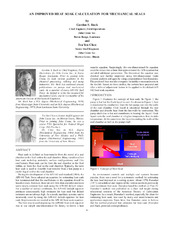| dc.contributor.other | International Pump Users Symposium (26th : 2010) | |
| dc.creator | Buck, Gordon S. | |
| dc.creator | Chen, Tsu Yen | |
| dc.date.accessioned | 2017-09-19T21:08:54Z | |
| dc.date.available | 2017-09-19T21:08:54Z | |
| dc.date.issued | 2010 | |
| dc.identifier.uri | https://hdl.handle.net/1969.1/162619 | |
| dc.description | Lecture | en |
| dc.description.abstract | Heat soak is defined as heat transfer from the metal of a seal chamber to the fluid within the seal chamber. Many variables affect heat soak including materials, surface configurations, and film coefficients. Heat soak can be from the seal chamber to the fluid within, or from the fluid to the seal chamber. Typically, the term heat soak is used to describe heat transfer from a hot pump to a cooler liquid within the seal chamber. During the development of the API 682 seal standard (2004), the API 682 Task Force adopted an equation for estimating heat soak but recommended that the coefficients in the equation should be based on tests. However, there are still little data available and most users simply estimate heat soak using the API 682 default values. For a number of service conditions, the API 682 default equation produces unnecessarily high estimates for heat soak but default estimates are not always high. As a result, auxiliary systems can be incorrectly sized by using the API 682 default equation for heat soak. Improvements are needed in the API 682 heat soak equation. The first step toward improving the API 682 heat soak equation was to use simple one-dimensional find theory to derive a heat transfer equation. Surprisingly, this one-dimensional fin equation could be recast into a form that approximated the API equation but included additional parameters. The theoretical fin equation was checked and further improved using two-dimensional finite element analysis and again by using computational fluid dynamics. The predicted heat transfer compares favorably to measurements in the test lab. Based on these studies, the authors have prepared and offer a table of adjustment factors to be applied to the default API 682 heat soak equation. | en |
| dc.format.medium | Electronic | en |
| dc.format.mimetype | application/pdf | |
| dc.language.iso | en | |
| dc.publisher | Turbomachinery Laboratory, Texas A&M University | |
| dc.relation.ispartof | Proceedings of the 26th International Pump Users Symposium | en |
| dc.subject.lcsh | Pumping machinery | en |
| dc.title | An Improved Heat Soak Calculation For Mechanical Seals | en |
| dc.title.alternative | Improved Heat Soak Calculation For Mechanical Seals | en |
| dc.type.genre | Presentation | en |
| dc.type.material | Text | en |
| dc.identifier.doi | https://doi.org/10.21423/R1RW6B | |


